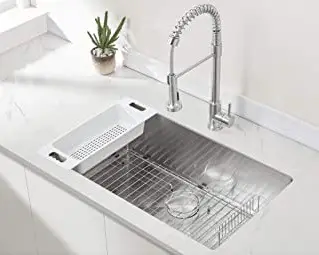In a day, the kitchen sink sees a lot from the left-over foods, grimy pots, pans, and other debris forms.
Due to the accumulation of grime and left-over foods, the dish disposer doesn’t always smell rosy.
This smell can extend to the rest of your house if the sink is not properly and often cleaned.
Make it a habit of thoroughly cleaning your sink on a regular basis, at least once a week, to get rid of odors.
Ensure to maintain the kitchen sink as guided by this article so as to prevent bacteria build-up, foul smells and sustain a healthy kitchen environment. There are also plenty of other resources on how to clean your kitchen like an expert.
Everyday Sink Maintenance
Regardless of what sink type you have, get rid of any food debris and use water and a mild soap for wiping the faucet and basin every day.
You will want to carry out a thorough once-a-week cleanup depending on the sink’s material, too. This should reduce the bacteria and help in maintaining the finish regardless of the material the sink is made of.
Cleaning a kitchen sink
What you need to clean your sink:

- Rubber gloves
- Baking soda
- White vinegar
- Lemon
- Non- abrasive scrubber
- Salt
- Dish soap
- Hydrogen peroxide
Procedure for cleaning different types of sinks:
Sanitize the kitchen sink basin
To begin the process, remove any dirty dishes, food items, or dish racks close to the working area. Rinse down any visible food particles or crumbs. Put on your gloves and get ready to start the job.
Kitchen sinks can be of different materials; therefore, the cleaning process is dependent on the type of kitchen sink available in your home.
Copper kitchen sinks
Though vinegar and baking soda work properly on many sinks, things as gentle as vinegar and baking soda can damage a copper’s finish.
The great news is that all you require for a copper sink is an everyday wash using mild dish soap.
Adhere to these tips for ensuring the sink stays fresh and is not damaged during cleaning:
- Do not use scrubbers; use damp sponges and wet cloths with dish soap for the occasional cleanup.
- Most regular cleaners can damage your sink’s finish, so try scrubbing with baking soda rinsed using a mild vinegar and then water.
- High acid food items such as citrus fruits will wear at the finish, so rinse properly after handling them.
- Never clean up too much: Taking into consideration that copper is a natural anti-bacterial, to ensure it stay clean, you simply need to rinse it.
Cleaning a stainless-steel kitchen sink
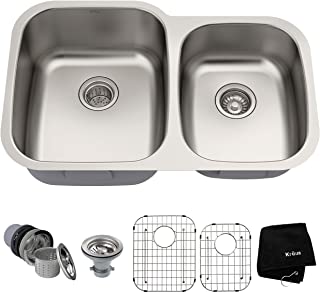
Compared to other kitchen sink materials, stainless steel is a very tough material. The material is resistant to most stains and the least likely to rust.
However, acidic foods, abrasive scrubbers, and bleach can damage the finishing of the material. Based on this fact, avoid having acidic foods stay in the sink for long periods.
Moreover, use baking soda to clean instead of bleach and opt for a mild abrasive.
First, pour some baking soda into the wet sink. Add a bit of dish soap and warm water to your sponge.
Start by scrubbing the sides of the sink basin as you move downwards. Wash the debris down the drain. Continue scrubbing with warm water and soap until there is no more scum left.
Rinse the sink with clean water. Stainless steel tends to leave water spots after every rinse. Wipe the sink basin with a dry microfiber cloth to dry and buff the sink.
Apart from the everyday clean up using dish soap, you should rinse this type of sink well after every use. This will help avoid pitting since salts and acids may damage the sink’s finish.
You can do a once-a-week clean up with the same procedure as that for ceramic and porcelain sinks.
Since stainless steel is especially susceptible to spotting, you might want to run a cloth drenched in vinegar along the surface as required to get rid of spots.
To clean up stubborn stains:
- Drench paper towels in vinegar.
- Use the towels to line the whole basin.
- Let the towels sit for about one hour, and then toss them away before cleaning up the sink thoroughly to get rid of any vinegar residue.
If you have any specific tough stains, you can use a commercial cleaner ideal for stainless steel as well.
Make sure you adhere to the manufacturer’s directions when you use this type of cleaner. Also, ensure you rinse and dry your sink thoroughly later on.
Cleaning a white kitchen sink
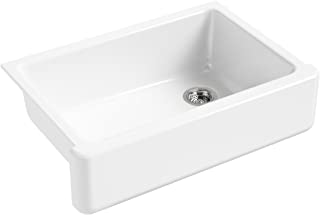
Unlike a stainless-steel sink, a white kitchen sink is more prone to stains from food splashes, coffee, wine, and rust.
Hydrogen peroxide and baking soda are ideal in this situation to remove stains and get it back to its initial state.
First, slightly dampen the sink with a wet cloth and cover it with baking soda. Pour drops of hydrogen peroxide on the baking soda.
Scrub with a sponge or a brush till it is clean and sparkling white.
Rinse with clean water as you push the mixture down the drain.
Cleaning up fireclay sinks
Fireclay won’t fade, stain or rust and is a sturdy, scratch-resistant material for the sink. A sink made of this material is the best compliment to any kitchen.
Stick to these simple steps to keep the fireclay sink good-looking:
- You can put on a thin liquid wax layer once every month. Allow it to dry after you apply before using the sink again.
- Don’t use ammonia
- Use towels or cloths; stay away from using hard scrubbers or steel wool as it can scratch your sink’s material.
- You can use mild abrasive cleaners for everyday clean up; however, stay away from using white vinegar or bleach to clean.
- For extra stubborn stains, use a solution of 50/50 mixture of water and bleach.
Cleaning Ceramic and Porcelain kitchen sink
Ceramic and porcelain are some of the most popular materials for making sinks and the simplest to clean, too.
Glossy porcelain is prone to rust and stains. The procedure of cleaning a porcelain sink is similar to the procedure followed when cleaning a white sink.
Ridding a porcelain sink of rusk: to get rid of rust, you may opt for a different method to safeguard porcelain’s pearly finish.
Cut a lemon into two, take one of the half and pour some salt on it, and scrub the affected area till all the rust clears.
Use warm soapy water to clean it more. Clean water is perfect to use for rinsing and a microfiber cloth to dry.
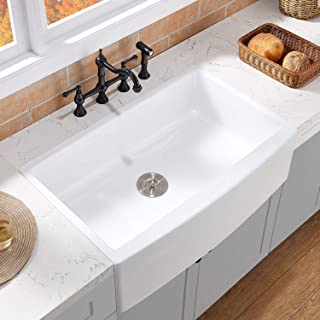
Cleaning a ceramic or porcelain sink: just use warm water to wet the sink, sprinkle bicarbonate of soda onto your sink and use a sponge or cloth to rub until it makes a paste.
The bicarbonate of soda will get rid of food residue, soap scum, and stains, as well as sparkle the sink.
Thereafter, use water to carefully rinse the whole sink, ensuring that you get rid of the entire baking soda residue, and then use a clean cloth to dry your sink.
For stubborn stains, use commercial cleansers based on the manufacturer’s directions. Stay away from steel wool and abrasive cleaners to stop scratches on your sink’s surface.
Cast iron kitchen sinks
It would be best if you rinsed cast iron with plain water after every use. It is important that you use a clean cloth to dry your sink thoroughly.
Clean cast iron sinks using the same weekly baking soda procedure used for ceramic and porcelain sinks.
Stay away from abrasive cleaners on cast iron. It’s hard to get rid of set-on stains without the use of something, which might damage the surface.
Never leave soiled dishes in your cast iron sink for a long time, and don’t leave any coffee grinds or tea bags in your sink.
Cleaning the faucets and handles
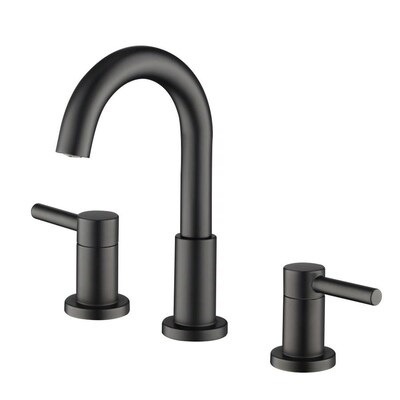
Cleaning the sink has to involve its counterparts. Regardless of the material used to make the handles and faucets, clean them with soapy water.
With a sponge or a brush, clean the faucets and handles. For the areas that are hard to reach, use a toothbrush to remove any debris.
White spots left after the cleaning process is due to the accumulation of lime from the tap water’s minerals.
To wipe off the spots, add a bit of vinegar to the soapy water and give it a final scrub.
Stone and stone composite kitchen sinks
Since stone is porous, it absorbs liquid, so you should avoid chemical and acid cleaners completely since they damage the stone easily.
Rather, use warm water and mild soap to clean up the sink whenever you use it and pat it dry at once. You can use a gentle brush to avoid the wet stone from becoming slimy.
Cleaning acrylic sinks
You can get these types of sinks in a range of sizes and shapes.
Though acrylic scratches easily, the material has a similar shade throughout. This implies that you can use acrylic scratch kits to easily sandpaper scratches.
Though stains on acrylic sinks are simple to fix, you can prevent them from occurring in the first place using these cleanup tips:
- You can use white vinegar and bleach on stubborn stains without damaging the acrylic. However, avoid allowing these acids to sit for a prolonged time.
- Do not place hot pans at the sink’s bottom part. Acrylic is tough on stains and mildew but isn’t heat resistant.
- Using rubbing alcohol on touch for grease stains to make sure you have a clean, stainless shine.
- Wipe the sink using soft towels or cloths with warm water and dish soap.
Cleaning up caulking
Caulking is the waterproof filler used to seal joints or cracks. It is capable of staining if not properly cleaned.
Make a paste using a small amount of water and baking soda and use an old toothbrush for cleaning up the caulk seal on the drain flaps in your sink’s bottom part, the faucet, and around the sink.
If your sink is made of stone or copper, the basin should not have baking soda. You should rinse thoroughly after clean up.
Cleaning the Drain and Disposal
The kitchen smells should always be inviting, mainly from nice smelling foods or spices.
However, the kitchen drain and disposal are among the few places that can bring about bad odor in your kitchen.
How do you clean the drain and disposal to prevent such odors?
Wash the drain with Baking Soda and White Vinegar
This is probably the easiest method to clear your drains and it is a plus since you are cleaning using natural products. The combo not only deodorizes your drain but is also perfect for unclogging your drain.
To start with, pour some baking soda down the drain. Following, slowly pour some vinegar down the drain as well.
Note that the ingredients should be in the ratio of one: two, respectively.
Let the mixture stay for a quarter an hour for the reaction to take effect.
After the fizzing stops, pour hot water down the drain to flush the mixture together with any left residue.
Cleaning the disposal with lemon, ice, and salt
Fill the garbage disposal with lemon slices, some ice cubes, and salt. Open the tap and let the water run.
At the same time, turn on the garbage disposal until there is no more ice left. Salt acts as an abrasive and scrubs the blades. Coarse salt like rock or sea salt is the best for this job.
On the other hand, ice removes any gunk or grime on the disposal.
The lemon gives your disposal a fresh citric scent.
Maintenance tips for your kitchen sink
- Safeguard your sink from permanent scratches. Having a plastic covering at the base of your sink is the most effective way to protect your sink’s surface from scratch marks.
- Avoid prolonged contact of acidic foods with your sink. Do not let acidic foods, fruits, and vinegar sit for long, especially on porcelain enamel sinks, as it could potentially etch on its surface. In case of a stain, instantly wipe off with a mixture of borax and lemon juice in an equal ratio.
- Keep your sinks free from clogs. Avoid disposing of food materials and other particles in the sink drain as this causes clogs. Instead, dispose of them in the bins.
- Clean the sink regularly as it makes each cleaning process easier as there is no buildup of grime.
- Avoid using harsh chemicals or cleaning agents on the sinks as they can damage the material.
Disinfect the sink
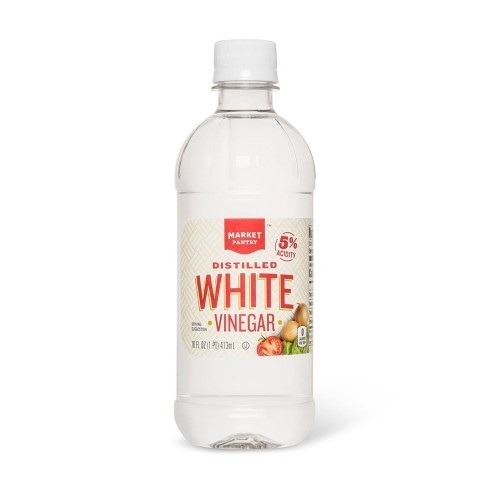
It would be best if you poured several vinegar cups into the plugged basin to disinfect a cast iron, ceramic, porcelain, or stainless-steel sinks.
After that, take out the towels, toss them away and use dish soap and water to rinse the sink to get rid of any remaining vinegar.
Don’t use vinegar on stone or copper sinks. Purchase a commercial stone disinfectant to disinfect stone and use it in accordance with the manufacturer’s instructions.
Copper disinfects naturally, so provided that your sink stays clean, you don’t have to worry about extra disinfecting.
Maintaining the sink in between cleanups
Frequent cleanups are an essential part of sink maintenance and keeping the house healthy. Between clean ups, you can ensure the sink remains clean by doing this:
- Do not leave dishes or other items in your sink for a prolonged time
- Rinse and dry your sink after use
- Using white vinegar to spray your sink after using
Simple tips for maintaining the sink
Protecting it from permanent stains and scratches
It’s a real accomplishment if you maintain a stain and scratch-free sink. Here are some things you can do to ensure the sink stays clean and in good condition:
- If you own a porcelain enamel kitchen sink, do not allow vinegar, fruits, or other acidic food items to stay on its surface. Prolonged exposure to acids will encourage staining and can permanently engrave on the sink’s surface.
- At your sink’s bottom part, you can put a perforated plastic covering. This will help protect its surface from acquiring scratches and mass and protect the dishes at the same time.
If your sink already has stains, don’t worry. Here’s a solution. Easily get rid of stain areas with a paste created with the juice from ½ lemon and ½ cup of powdered borax.
With a wet sponge, put a bit of the mixture onto the stained area. Use running water for rubbing, rinsing, and washing.
Your sink will look great, whether made of stainless steel, porcelain enamel, or any other material.
Dealing with and controlling the formation of rust
To manage the formation of rust on the stainless-steel sink, simply use a clean cloth to wipe WD-40 on the corroded area before rinsing thoroughly.
You can also use coca-cola or lighter fluid in place of WD-40.
For porcelain enamel kitchen sinks rust stains, simply place table salt on half of a lemon and rub it on the blemish.
Adhering to these steps can ensure rust stays away and can maintain the sink’s spotless condition.
Keeping the sink’s drain free from clog
Adhering to these easy-to-follow steps will ensure the kitchen sink drains free from the clog.
Combine:
- ¼ cup cream of tartar
- A bit of salt
- A small amount of bicarbonate of soda
After mixing, keep the mixture in a sealed, childproof, and airtight container.
Every couple of weeks, pour approximately ½ cup of this mixture down the drain of your sink and then pour boiling water.
Make sure you keep soap, grease, food, hair, and other debris from the kitchen sink drains to start with.

